Logging Identification Method for Reservoir Facies in Fractured-Vuggy Dolomite Reservoirs Based on AI: A Case Study of Ediacaran Dengying Formation, Sichuan Basin, China
Abstract
:1. Introduction
2. Geological Setting
3. Method and Process
3.1. Reservoir Facies Identification Method
3.1.1. Unsupervised Intelligent Clustering Method Based on FCM-DSDFP
3.1.2. Fusion Method Based on PCA Dimensionality Reduction and Noise Reduction
3.1.3. Principles of Cluster Feature Analysis
3.2. The Recognition Process of Intelligent Clustering Based on PCA-FCM
4. Results and Testing
4.1. Reservoir Facies Identification Results
4.2. Reservoir Facies Characteristics
4.2.1. Dengying Formation 4th Member
4.2.2. Dengying Formation 2nd Member
4.3. Testing Methods
5. Conclusions
Author Contributions
Funding
Institutional Review Board Statement
Informed Consent Statement
Data Availability Statement
Conflicts of Interest
References
- Li, K.; Gong, B.; Zhang, X.; Jiang, H.; Fan, J.; Tan, Y. A comparison of hydrothermal events and petroleum migration between Ediacaran and lower Cambrian carbonates, Central Sichuan Basin. Mar. Pet. Geol. 2023, 150, 106130. [Google Scholar] [CrossRef]
- Gu, Y.; Wang, Z.; Yang, C.; Luo, M.; Jiang, Y.; Luo, X.; Zhou, L.; Wang, H. Effects of diagenesis on quality of dengying formation deep dolomite reservoir, Central Sichuan Basin, China: Insights from petrology, geochemistry and in situ U-Pb dating. Front. Earth Sci. 2023, 10, 1041164. [Google Scholar] [CrossRef]
- Su, A.; Chen, H.; Feng, Y.; Zhao, J.; Wang, Z.; Hu, M.; Jiang, H.; Nguyen, A. In situ U-Pb dating and geochemical characterization of multi-stage dolomite cementation in the Ediacaran Dengying Formation, Central Sichuan Basin, China: Constraints on diagenetic, hydrothermal and paleo-oil filling events. Precambrian Res. 2022, 368, 106481. [Google Scholar] [CrossRef]
- Wang, H.; Jiang, Y.; Yang, C.; Zhang, B.; Gu, Y.; Luo, X.; Zhou, L.; Wang, Z. Hydrothermal silicification in Ediacaran Dengying Formation fourth member deep dolomite reservoir, Central Sichuan Basin, China: Implications for reservoir quality. Geol. J. 2023, 58, 4257–4270. [Google Scholar] [CrossRef]
- Gu, Y.; Zhou, L.; Jiang, Y.; Jiang, C.; Luo, M.; Zhu, X. A Model of Hydrothermal Dolomite Reservoir Facies in Precambrian Dolomite, Central Sichuan Basin, SW China and its Geochemical Characteristics. Acta Geol. Sin. (Engl. Ed.) 2019, 93, 130–145. [Google Scholar] [CrossRef]
- Luo, J.; Wang, F.; He, S.; He, Z.; Huang, Y.; Zhang, D.; Zhu, Y.; Sun, Z.; Luo, T. Characteristics of Vein-Forming Fluids in the Sinian Dengying Formation Reservoir and Its Relationship with the Hydrocarbon Accumulation Process in the Southwest and Southeast of the Sichuan Basin. Minerals 2022, 12, 443. [Google Scholar] [CrossRef]
- Ma, Y.; Cai, X.; Yun, L.; Li, Z.; Li, H.; Deng, S.; Zhao, P. Practice and theoretical and technical progress in exploration and development of Shunbei ultra-deep carbonate oil and gas field, Tarim Basin, NW China. Pet. Explor. Dev. 2022, 49, 1–20. [Google Scholar] [CrossRef]
- Lonnee, J.; Machel, H. Pervasive dolomitization with subsequent hydrothermal alteration in the Clarke Lake gas field, Middle Devonian Slave Point Formation, British Columbia, Canada. AAPG Bull. 2006, 90, 1739–1761. [Google Scholar] [CrossRef]
- Gu, Y.; Zhou, L.; Jiang, Y.; Ni, J.; Li, J.; Zhu, X.; Fu, Y.; Jiang, Z. Reservoir types and gas well productivity models for Member 4 of Sinian Dengying Formation in Gaoshiti block, Sichuan Basin. Acta Pet. Sin. 2020, 41, 574–583. [Google Scholar]
- Feng, M.; Wu, P.; Qiang, Z.; Liu, X. Duan, Y.; Xia, M. Hydrothermal dolomite reservoir in the Precambrian Dengying Formation of central Sichuan Basin, Southwestern China. Mar. Pet. Geol. 2017, 82, 206–219. [Google Scholar] [CrossRef]
- Jiang, Y.; Tao, Y.; Gu, Y.; Wang, Y.; Qiang, Z.; Jiang, N.; Lin, G.; Jiang, C. Hydrothermal dolomitization in Sinian Dengying Formation, Gaoshiti-Moxi area, Sichuan Basin, NW China. Pet. Explor. Dev. 2016, 43, 54–64. [Google Scholar] [CrossRef]
- Ma, Y.; Cai, X.; Li, H.; Zhu, D.; Zhang, J.; Yang, M.; Duan, J.; Deng, S.; You, D.; Wu, Z.; et al. New in sights into the formation mechanism of deep-ultra-deep carbonate reservoirs and the direction of oil and gas exploration in extra-deep strata. Earth Sci. Front. 2023, 30, 1–13. [Google Scholar]
- Tan, L.; Liu, H.; Chen, K.; Ni, H.; Zhou, G.; Zhang, X.; Yan, W.; Zhong, Y.; Lv, W.; Tan, X.; et al. Sequence sedimentary evolution and reservoir distribution in the third and fourth members of Sinian Dengying Formation, Gaomo area, Sichuan Basin, SW China. Pet. Explor. Dev. 2022, 49, 871–883. [Google Scholar] [CrossRef]
- Su, A.; Chen, H.; Feng, Y.; Zhao, J.; Nguyen, A.; Wang, Z.; Long, X. Dating and characterizing primary gas accumulation in Precambrian dolomite reservoirs, Central Sichuan Basin, China: Insights from pyrobitumen Re-Os and dolomite U-Pb geochronology. Precambrian Res. 2020, 350, 105897. [Google Scholar] [CrossRef]
- Dai, X.; Du, B.; Zhang, M.; Li, J.; Tang, T.; Xu, Y.; Gan, L.; Sun, X. Reunderstanding and significance of high-quality reservoirs of the inner Dengying Formation in the Anyue Gas Field. Nat. Gas Ind. 2019, 39, 11–21. [Google Scholar] [CrossRef]
- Zhu, X.; Gu, Y.; Jiang, Y.; Tang, T.; Xu, W.; Li, K.; Deng, H. Characteristics and reservoir body classification & evaluation of Sinian Dengying karst reservoirs in the Gaoshiti Block of central Sichuan Basin. Nat. Gas Ind. 2019, 39, 38–46. [Google Scholar]
- Yan, H.; He, D.; Jia, A.; Li, Z.; Guo, J.; Peng, X.; Meng, F.; Li, X.; Zhu, Z.; Deng, H.; et al. Characteristics and development model of karst reservoirs in the fourth member of Sinian Dengying Formation in central Sichuan Basin, SW China. Pet. Explor. Dev. 2022, 49, 704–715. [Google Scholar] [CrossRef]
- Li, Z.; Zhang, L.; Chen, X.; Zhao, H.; Jin, Q. Logging identification of fractured-vuggy carbonate reservoirs: Case study from the second section of Lianglitage Formation in the eastern part of Tazhong area. Nat. Gas Geosci. 2019, 30, 1805–1814. [Google Scholar]
- Xu, Z.; Lan, C.; Ma, X.; Hu, C.; Chen, H.; Li, P.; Zou, H. Sedimentary Models and Physical Properties of Mound-Shoal Complex Reservoirs in Sinian Dengying Formation, Sichuan Basin. Earth Sci. 2020, 45, 1281–1294. [Google Scholar]
- Tian, H.; Zhang, J.; Li, C.; Li, W.; Yao, Q. The Application of Image Logging in the Identification of Microbialite Facies in Dengying Formation, Sichuan Basin. J. Southwest Pet. Univ. (Sci. Tecnol. Ed.) 2020, 42, 75–85. [Google Scholar]
- Wu, W.; Xiao, L.; Zhang, L. Neutron and density logging responses to gas reservoir for well-balanced and under-balanced logging: Gas reservoirs of sandstone in a western China field. Sci. China Ser. D Earth Sci. 2008, 51, 201–206. [Google Scholar] [CrossRef]
- Li, Z.; Gao, C.; Zhao, B.; Guan, Y.; Liu, J. Application of nuclear magnetic resonance logging in the low-resistivity reservoir — Taking the XP area as an example. Interpret. J. Subsurf. Charact. 2020, 8, T885–T893. [Google Scholar] [CrossRef]
- Wang, B.; Li, W.; Lu, J.; Jin, W.; Hu, S. Study on acoustic logging response of fractured reservoirs using a novel equivalent medium model. Acta Geophys. 2022, 70, 2595–2704. [Google Scholar] [CrossRef]
- Bai, Y.; Tan, M.; Xiao, C.; Han, C.; Wu, H.; Luo, W.; Xu, B. Dynamic classification committee machine-based fluid typing method from wireline logs for tight sandstone gas reservoir. Chin. J. Geophys. 2021, 64, 1745–1758. [Google Scholar]
- Wei, Y.; Guo, K.; Xu, J. Application of FCM Clustering Algorithm to Electrofacies Analysis. Sci. Technol. Manag. Land Resour. 2012, 29, 111–114. [Google Scholar]
- Shao, R.; Shi, Y.; Zhou, J.; Xiao, L.; Liao, G.; Hou, S. Construction of machine learing data set for geophysical logging inversion. Chin. J. Geophys. 2023, 66, 3086–3101. [Google Scholar]
- Rambabu, R.; Vadakkepat, P.; Tan, K.; Jiang, M. A Mixture-of-Experts Prediction Framework for Evolutionary Dynamic Multiobjective Optimization. IEEE Trans. Cybern. 2020, 50, 5099–5112. [Google Scholar] [CrossRef]
- Wang, Z.; Wang, S.; Du, H. Improved Fuzzy C-means Clustering Algorithm Based on Density-Sensitive Distance. Comput. Eng. 2021, 47, 88–96, 103. [Google Scholar]
- Xu, F.; Xu, G.; Liang, J.; Yuan, H.; Liu, Y.; Xu, F. Multi-Stage Fluid Charging and Critical Period of Hydrocarbon Accumulation of the Sinian Dengying Formation in Central Sichuan Basin. Acta Geol. Sin. (Engl. Ed.) 2016, 90, 1549–1550. [Google Scholar]
- Fan, J.; Jiang, H.; Lu, X.; Liu, Q.; Liu, S.; Ma, X.; Huang, S.; Zeng, F.; Tian, H.; Xie, W. Pressure evolution and hydrocarbon accumulation process of Sinian Dengying Formation gas reservoirs in the Penglai area, Sichuan Basin. Nat. Gas Ind. 2022, 42, 32–43. [Google Scholar]
- Shen, A.; Li, J.; Long, X.; Hu, A.; Liu, J.; Yin, Q.; Gong, Z. Re-Os dating and oil-source correlation of the pyrobitumen in the Member 4, Dengying Formation of the Kangjiadong paleo-reservoir, northern margin of the Sichuan Basin. Acta Petrol. Sin. 2022, 38, 1702–1712. [Google Scholar]
- Li, C.; Chen, H.; Xiao, X.; Wang, Z.; Jiang, H. Raman spectroscopy of bitumen from the Sinian Dengying Formation reservoirs, Gaoshiti-Moxi area, central Sichuan Basin. Oil Gas Geol. 2022, 43, 456–466. [Google Scholar]
- Fang, X.; Deng, B.; Geng, A.; Liu, S.; Wang, P.; Liang, X.; Li, Y.; Cheng, B.; Jiang, W.; Wu, L. Geochemical properties, mechanism of formation, and source of solid bitumen in the Ediacaran Dengying Formation from the central to northern Sichuan Basin, China. Mar. Pet. Geol. 2024, 159, 106573. [Google Scholar] [CrossRef]
- Jiang, H.; Li, W.; Huang, S.; Jiang, Q.; Zhai, X.; Gu, Z.; Xie, W.; Wang, R. Process and model of hydrocarbon accumulation spanning major tectonic phases of Sinian Dengying Formation in the Sichuan Basin. Nat. Gas Ind. 2022, 42, 11–23. [Google Scholar]
- Shen, A.; Zhao, W.; Hu, A.; Wang, H.; Liang, F.; Wang, Y. The dating and temperature measurement technologies for carbonate mineralsand their application in hydrocarbon accumulation research in thepaleo-uplift in central Sichuan Basin, SW China. Pet. Explor. Dev. 2021, 48, 476–487. [Google Scholar] [CrossRef]
- Li, P.; Guo, X.; Hao, F.; Zou, H.; Yu, X.; Wang, G. Paleo-Oil-Reservoirs Reconstruction and Oil Correlation of Changxing Formation in the Yuanba Gas Field, Sichuan Basin. Earth Sci. J. China Univ. Geosci. 2016, 3, 452–462. [Google Scholar]
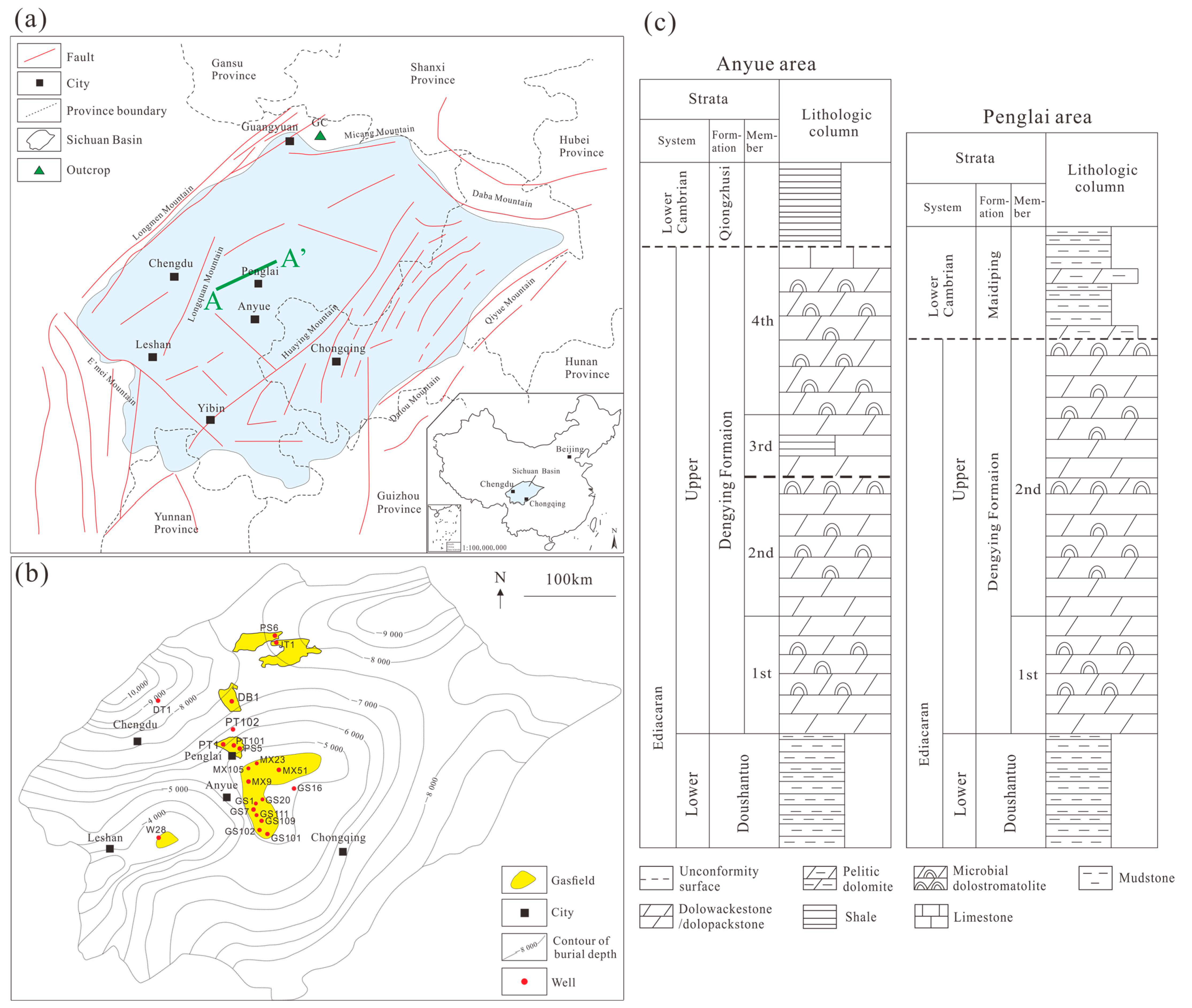

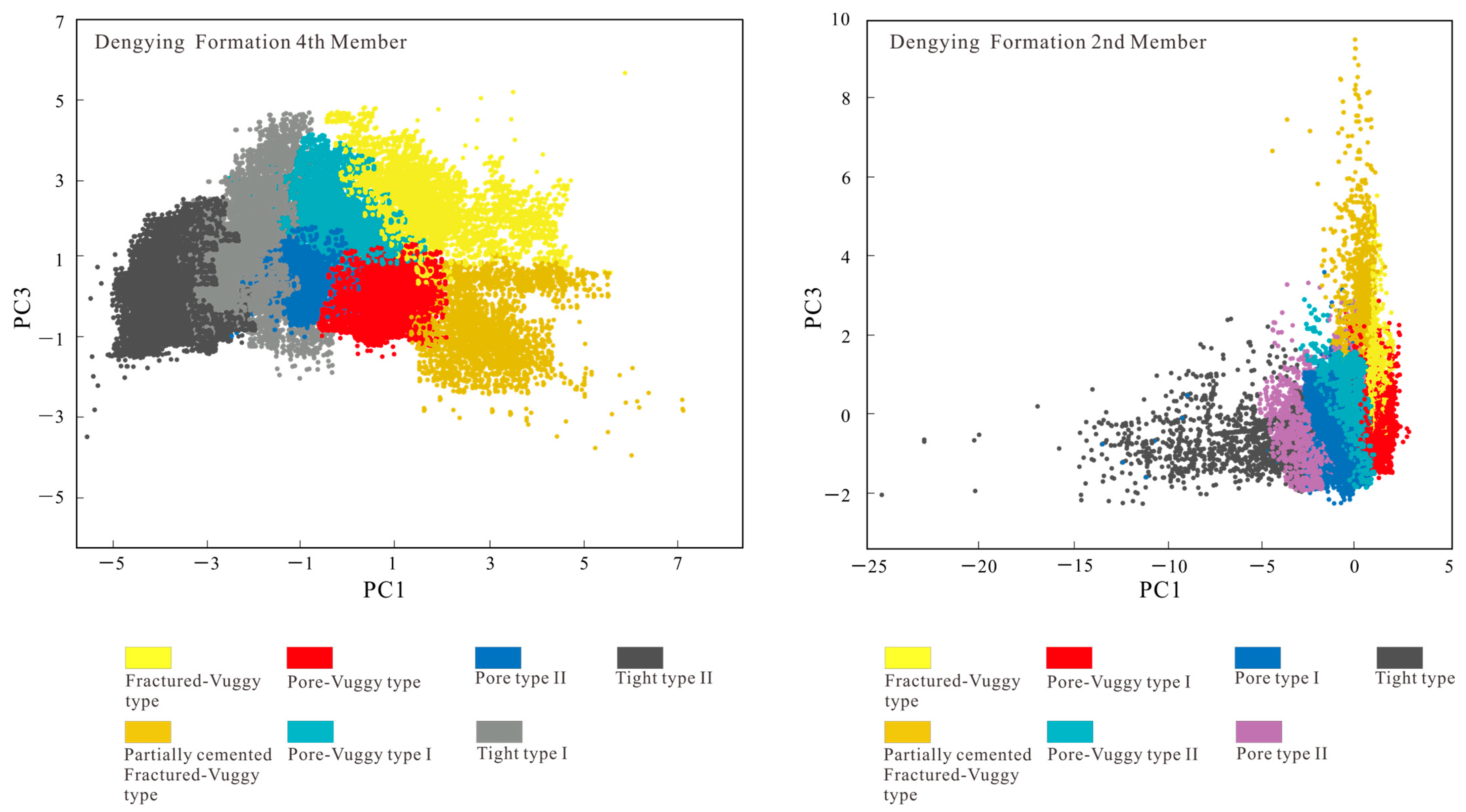
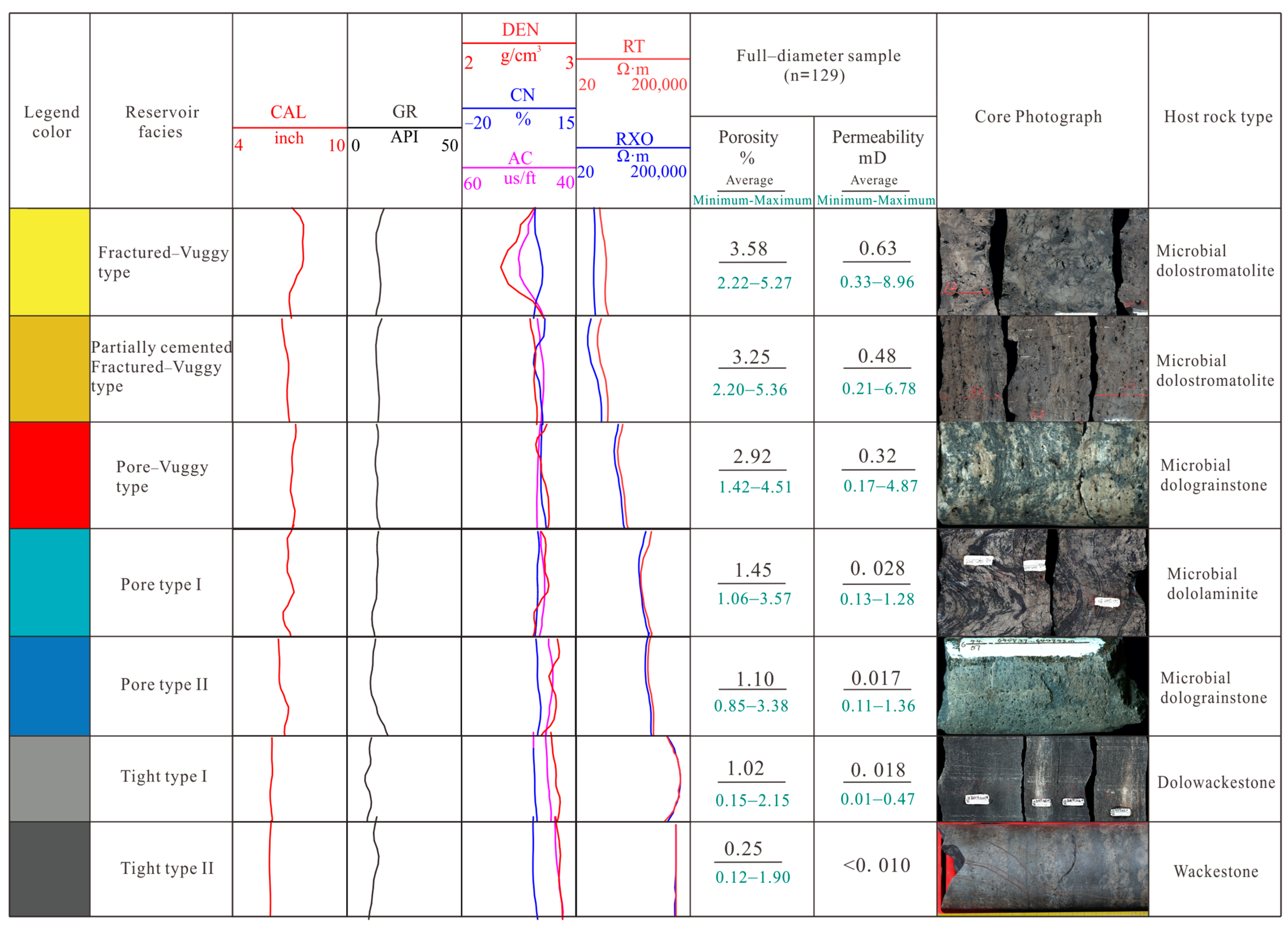
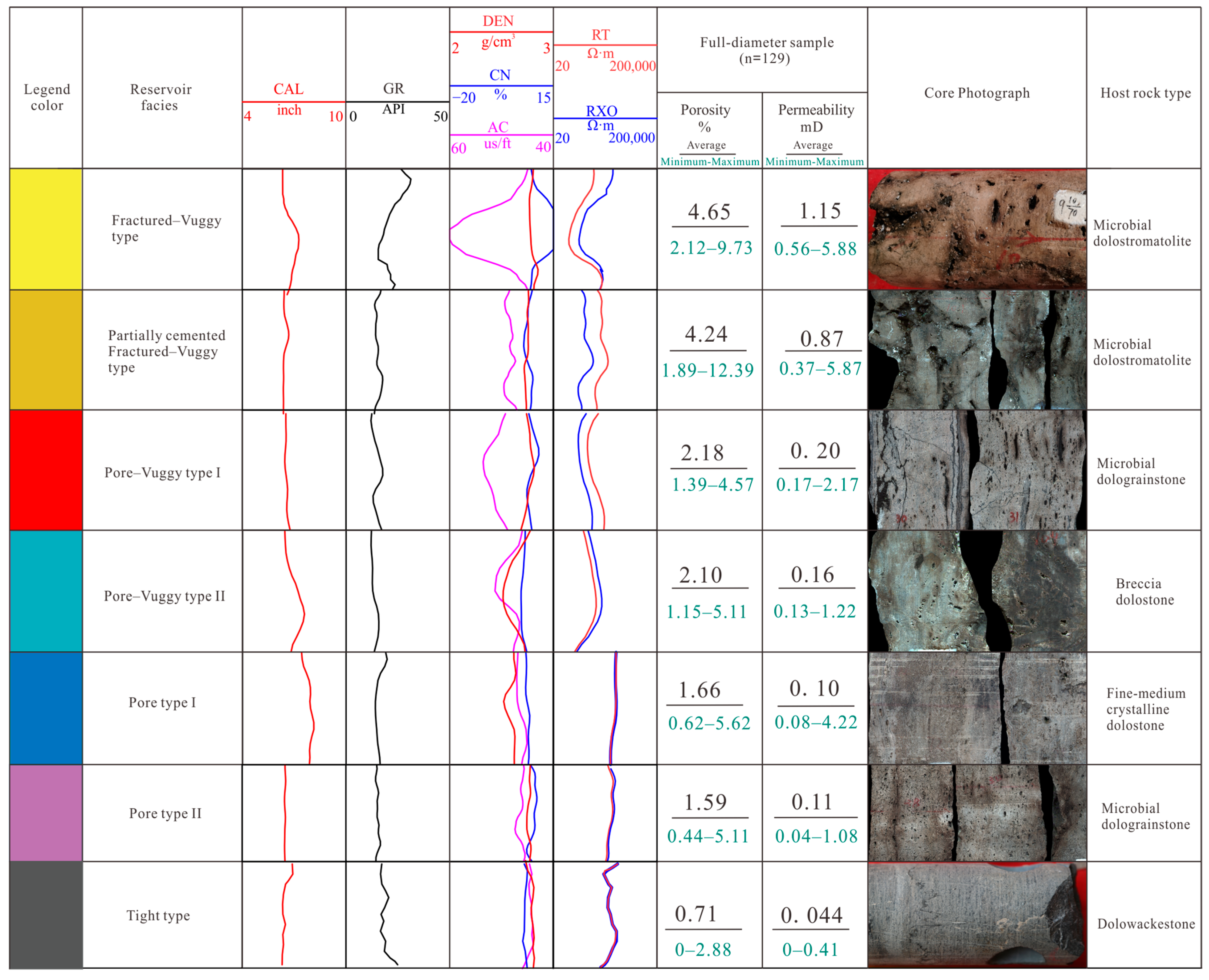

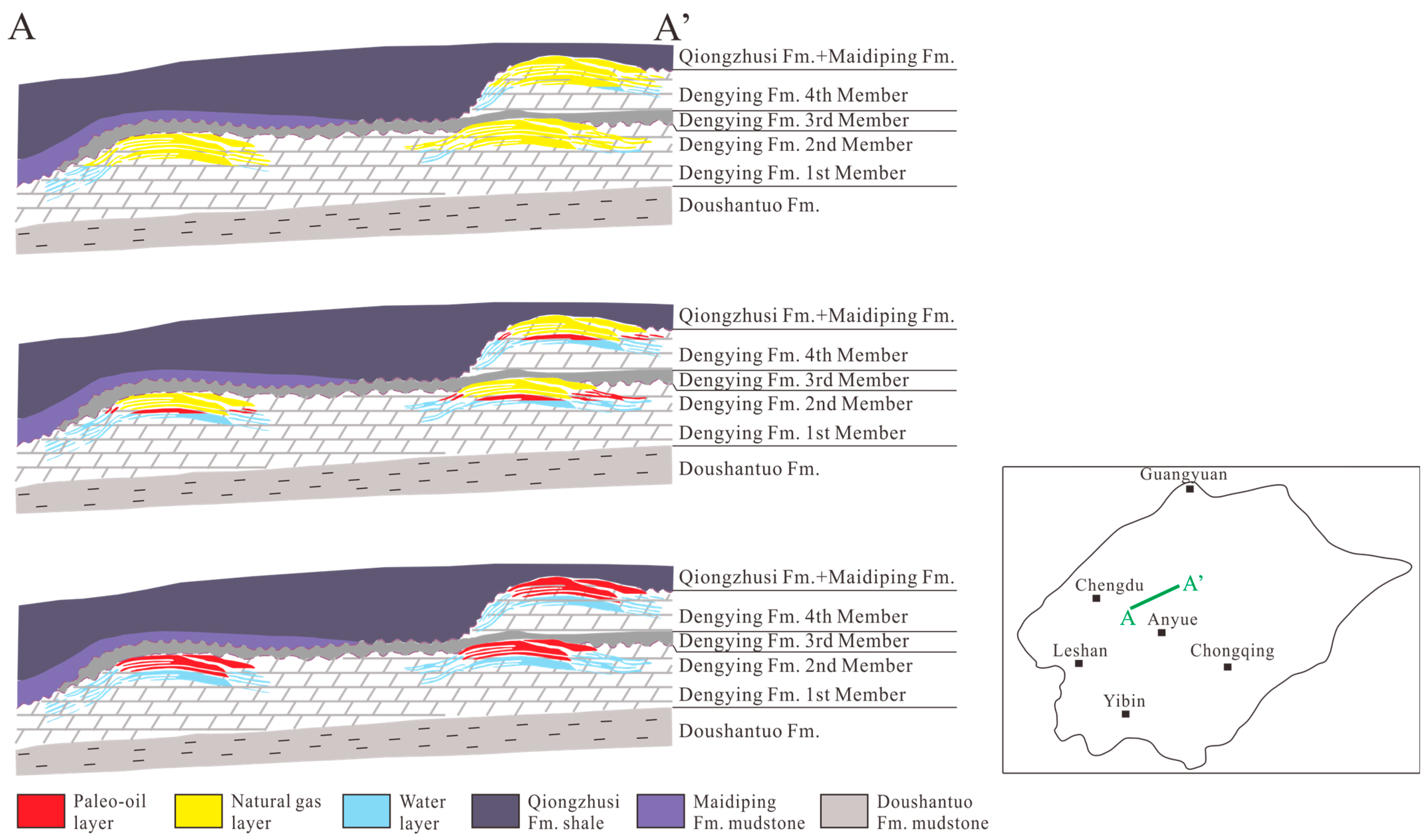


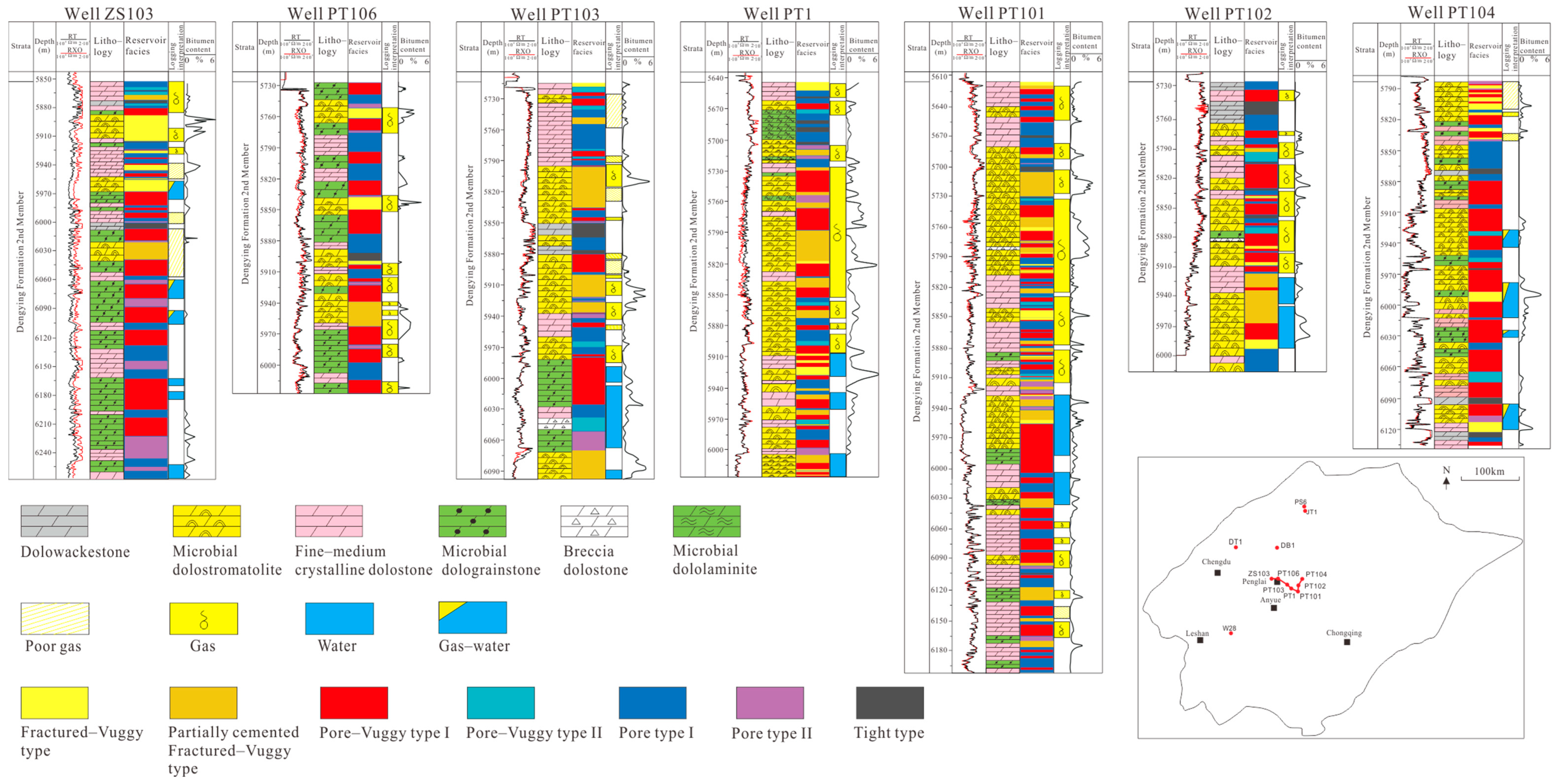
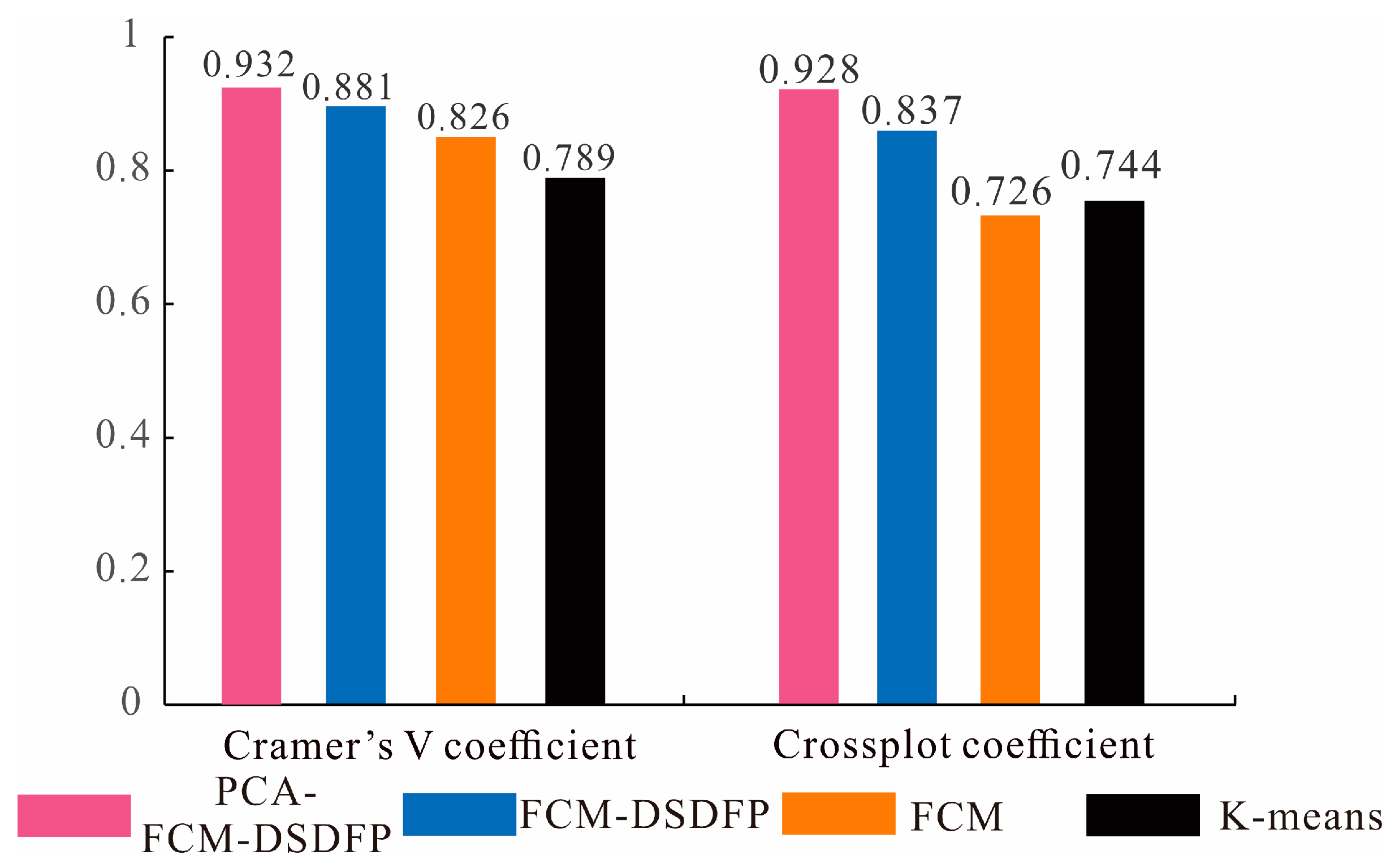
| Dengying Formation 4th Member | Dengying Formation 2nd Member | ||||||||||
|---|---|---|---|---|---|---|---|---|---|---|---|
| PC1 | PC2 | PC3 | PC4 | PC5 | PC1 | PC2 | PC3 | PC4 | PC5 | ||
| DEN | 0.1 | 0.56 | −0.76 | 0.29 | −0.08 | DEN | 0.07 | −0.72 | 0.01 | −0.69 | 0.06 |
| AC | 0.03 | −0.61 | 0.62 | −0.49 | 0.01 | AC | −0.05 | 0.01 | 0.95 | −0.01 | 0.01 |
| RT | −0.65 | −0.15 | −0.05 | 0.19 | −0.72 | RT | −0.7 | 0.01 | −0.04 | −0.02 | 0.71 |
| RXO | −0.65 | 0.1 | −0.13 | 0.26 | 0.69 | RXO | −0.69 | 0.04 | −0.03 | −0.18 | −0.69 |
| CNL | 0.37 | −0.54 | −0.05 | 0.76 | −0.02 | CNL | 0.12 | 0.69 | −0.01 | −0.7 | 0.1 |
| GR | 0.23 | 0.14 | −0.31 | 0.11 | 0.03 | GR | 0.1 | 0.01 | 0.02 | 0.15 | 0.22 |
| K | 0.16 | 0.01 | 0.04 | 0.26 | −0.3 | K | 0.16 | −0.01 | 0.01 | 0.14 | 0.1 |
| Th | 0.25 | 0.11 | 0.05 | 0.12 | 0.01 | Th | 0.25 | −0.11 | 0.06 | 0.01 | 0.01 |
| U | 0.03 | 0.06 | 0.19 | 0.05 | 0.07 | U | −0.03 | 0.06 | −0.01 | 0.11 | 0.07 |
| PE | 0.26 | 0.16 | 0.21 | −0.17 | 0.22 | PE | −0.21 | 0.16 | 0.11 | −0.17 | 0.12 |
| Vector value | 1.99 | 1.67 | 0.71 | 0.43 | 0.2 | Vector value | 1.77 | 1.35 | 1 | 0.65 | 0.24 |
| Information | 0.4 | 0.33 | 0.14 | 0.09 | 0.04 | Information | 0.35 | 0.27 | 0.2 | 0.13 | 0.05 |
| Accumulated information | 0.4 | 0.73 | 0.87 | 0.96 | 1 | Accumulated information | 0.35 | 0.62 | 0.82 | 0.95 | 1 |
Disclaimer/Publisher’s Note: The statements, opinions and data contained in all publications are solely those of the individual author(s) and contributor(s) and not of MDPI and/or the editor(s). MDPI and/or the editor(s) disclaim responsibility for any injury to people or property resulting from any ideas, methods, instructions or products referred to in the content. |
© 2024 by the authors. Licensee MDPI, Basel, Switzerland. This article is an open access article distributed under the terms and conditions of the Creative Commons Attribution (CC BY) license (https://creativecommons.org/licenses/by/4.0/).
Share and Cite
Ye, Y.; Jiang, Z.; Liu, X.; Wang, Z.; Gu, Y. Logging Identification Method for Reservoir Facies in Fractured-Vuggy Dolomite Reservoirs Based on AI: A Case Study of Ediacaran Dengying Formation, Sichuan Basin, China. Appl. Sci. 2024, 14, 7504. https://doi.org/10.3390/app14177504
Ye Y, Jiang Z, Liu X, Wang Z, Gu Y. Logging Identification Method for Reservoir Facies in Fractured-Vuggy Dolomite Reservoirs Based on AI: A Case Study of Ediacaran Dengying Formation, Sichuan Basin, China. Applied Sciences. 2024; 14(17):7504. https://doi.org/10.3390/app14177504
Chicago/Turabian StyleYe, Yu, Zengzheng Jiang, Xiangjun Liu, Zhanlei Wang, and Yifan Gu. 2024. "Logging Identification Method for Reservoir Facies in Fractured-Vuggy Dolomite Reservoirs Based on AI: A Case Study of Ediacaran Dengying Formation, Sichuan Basin, China" Applied Sciences 14, no. 17: 7504. https://doi.org/10.3390/app14177504





